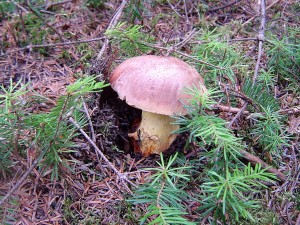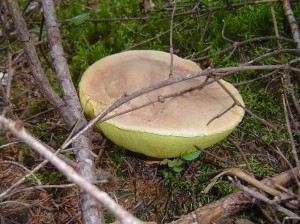Here is a common Maritime mushroom I’ve avoided doing a post on as some folks will experience allergic reaction to members of this (butter bolete group), even common edibles such as Blewits will cause some people issues, this of course goes beyond wild mushrooms, it’s across the board with foods we find in stores or forest. I’m not sure of the percentage who will develop GI symptoms from eating these but I suspect it is over 1 in 10 so you may want to not chance this one, for those who try it and it agrees with your system it is an excellent edible. Again though unless you have a long list of wild edible mushrooms you have already tried, it would be unwise to experiment eating one like this early on. This mushroom should be thinly sliced and cooked long. I usually dry them as I like most bolete type mushroom dried to enhance their flavour.
This is a young version, pore surface bright yellow and thin to the cap flesh, stem short and robust.
Here we see the fishnet markings on the right side of the stem which help in identify this mushroom.
Older mushroom with gill layer very thick, on most bolete family members this would mean this mushroom would be too soft and worm holes throughout.
Older mushroom flipped over.
1Left scribed on pores, this helps to ID as the pores should blue quickly after touched.
Here we see the flesh under the thick pore layer still solid and suitable for the table.
I should also mention these mushrooms dry very nicely and have an unusual aroma which I couldn’t find a good description of until someone who visited asked if a cake was in the oven and yes a homemade white cake or sugared lemon loaf fresh from the oven does smell similar, believe it or not. I may try the mushroom powder in desserts or pancakes.










A most interesting post, thank you! We have boletes here in France. An old farmer here told us they were edible but not particularly tasty, and because there are a number of other well-known edibles in our woods we have stuck to those. It was most interesting seeing how you peeled off the thick pore layer to reveal the flesh that you eat.
Jude the best known bolete throughout much of the world is the Porcini/ Cep / King Bolete which is very choice. A few are also very good fresh and dried are nice in soups. The pore layer usually is removed except on very young mushrooms that have a thin pore layer.
Our area is famous for cepes and I know them well. They’re around at the moment!